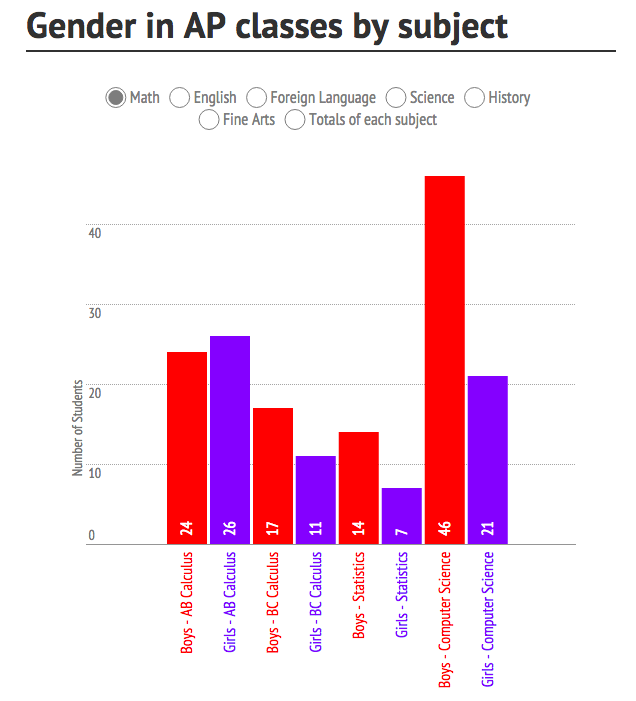Exploring gender differences within AP classes
According to the U.S. News and World Report, almost half of all Wayland High School students will take at least one AP class during their high school career. WSPN has found a marked difference in the proportion of girls and boys in certain AP classes.
Computer science teacher Michael Hopps noticed a gender disparity within his three AP classes and explained how this can be reflective of the gender gap found in the computer science field in general.
“If you look at the industry, there is a wide gender gap,” Hopps said. “It’s a predominantly male field.”
Although there continues to be a gender disparity in his AP Computer Science classes, Hopps notices that it has narrowed in the past few years. This year, a new record has been set with about one-third of his students being girls.
“Last year, it was more like 15 to 20 percent girls, and the year before that it was like 10 percent, so we’re on an upward trend,” Hopps said. “I think it’s because there’s been good word of mouth about the class.”
Hopps believes that the reason for the gender gap within classes does not come from inside WHS, but rather from outside societal pressure.
“I think [the reason fewer girls take AP Computer Science] is more of a societal stereotype issue and less to do with the subject matter,” Hopps said. “It’s the way that our culture portrays things, and it’s not completely accurate.”
Although Hopps thinks the reason for the gender imbalance comes from outside WHS, he feels the WHS community should have a serious discussion about these pressures.
“I think it’s worthwhile to talk about in all senses,” Hopps said.
In Spanish teacher Jill Swenson’s AP class, there are 13 female and four male students. She agrees that the imbalance of girls and boys is caused by society pushing different genders toward certain subjects.
“I think a lot of it comes from how we socialize and how we socialize our kids,” Swenson said. “I think through our socialization, we tend to draw boys toward science and math and girls toward language and reading.”
Senior and AP Computer Science student Derek Chen believes the influence that eventually leads to gender gaps is exerted before students even enter high school.
“I would say the gender gap starts developing in younger grades,” Chen said. “The younger you are, the more susceptible you are [to societal influences], so the gender gap starts in the early stages of life.”
Because of this already established impact, he imagines it to be almost impossible to adjust the gender gap now.
“The only way to change the gender gap would be in the early stages, in elementary school,” Chen said. “That’s the only way, I would say. At this point, our ideals are mostly solidified.”

meee • Nov 23, 2014 at 10:59 PM
why no comment on the gap in english?????????????????????????